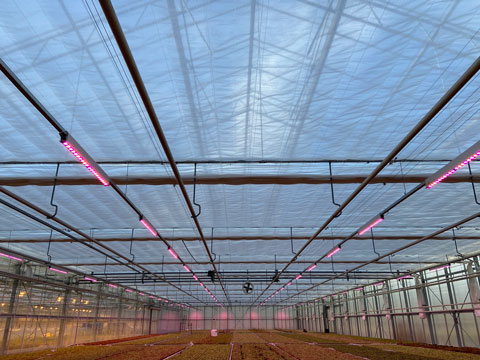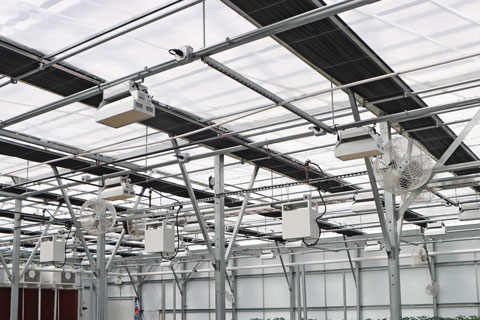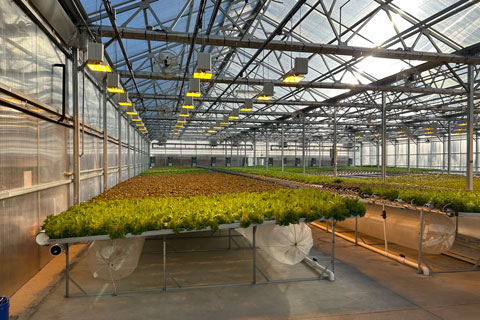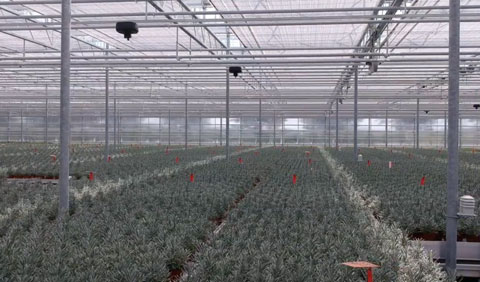4/1/2023
Tech in the Greenhouse
Jennifer Zurko

We’re seeing technology changing rapidly in almost all aspects of our lives. Not just in the daily devices that we use, like our laptops and smartphones, but also at places like the grocery store that are seeing more self-checkout lines, and at restaurants where you can order and pay from your phone without talking to a person or leaving your table.
For technophobes who have a hard time keeping up with all of this influx, it’s overwhelming and daunting. But it’s important to understand why these things are happening and be open to embracing the changes that help make your life easier.
Pictured: An energy curtain with LED lighting in a prop house. Photo courtesy of Prospiant.
Most of the new tech we’re seeing boils down to one reason: lack of resources. There aren’t enough servers to bring your food or enough cashiers at the grocery store, so those industries have had to figure out how to alleviate the problem while still providing those services to their customers.
In the growing biz, it’s no different. We’re experiencing a lack of resources, too—and have been for years—so it’s expected that some of the technology that we’re seeing in other industries to address labor shortages have made their way into the greenhouse.
But if you step back, you realize that the focus hasn’t just been on the lack of hands—growers are also looking for new ways to continuously improve on quality in a shorter and shorter amount of time.
What’s changed
According to Greg Ellis, VP of sales for Atlas Greenhouses, changes in greenhouse technology have been extensive and rapid.
“We have gone from traditional passive, fan-and-pad—or in some cases, positive pressure structures utilizing a combination of supplemental heating, cooling and lighting—to a totally sealed plant factory requiring all inputs to be supplied artificially,” he said.
He attributes the impetus of this to the cannabis and indoor vegetable growers’ demands for a near-perfect growing environment. For the more “traditional” ornamentals greenhouse grower, many aspects of this have been positive. Greg noted that it’s driven advancements in lighting, irrigation, materials handling, environmental controls and the structure itself, allowing growers to grow better crops faster and more consistently.
 But he feels that some of these advancements have made growers’ expectations too high.
But he feels that some of these advancements have made growers’ expectations too high.
Pictured: An example of some greenhouse technology (lights, fans and a shade curtain system) that can be controlled from a smart device. Photo courtesy of GrowSpan.
“Old school guys like me look at a greenhouse as simply protection against the extremes. They are meant to work with Mother Nature—not against her—capturing the free elements that she provides, like light, water, temperature, humidity and C02, while maintaining a protective assurance when she gets out of hand. Greenhouses used in this manner are the true definition of sustainability, and what we and our society give so much reverence to.”
Tony Abbas, Strategy & Business Development on the CEA side for Prospiant, said that COVID helped to ramp up a lot of the new technology we’re seeing coming into the greenhouse. He feels that the pandemic shifted growers’ thinking, empowering them to ask for new technology to help them be better and more efficient. The needs and demands have driven innovation.
“I’ve been in this industry for almost 14 years. We haven’t seen tech like what we’ve seen in the last three years—ever,” he said.
Today’s tech
Automation & AI
If you’re a regular goer to Cultivate, you know that the booths with the fancy transplanters, seeders and materials-handling machines are always multiple people deep. There’s obviously a fascination with new technology, but these machines are meant to solve a problem, mostly the lack of labor. Less hands means you need more help with sowing and transplanting, but it also means you have less eyes scouting for issues.
Companies like IUNU are developing special cameras and sensors that can detect problems in the greenhouse before they’re even seen with the human eye, allowing you to deal with them before they get out of hand.
A lot of this technology is coming from other industries and sectors of agriculture that are starting to make its way into horticulture.
“If it wasn’t for significant investments coming into controlled ag, we wouldn’t be having the advancements in vertical farming and cultivation practices that we’ve had,” said Tony. “It’s because of what these AI companies are doing in other industries. Look at drones. The tech’s out there—they’re focusing on our industry because there’s opportunity here.”
 Pictured: A hydroponic leafy greens house with production stationary gutters, positive pressure inflation tubes beneath the benches, supplemental lighting above the plants and a flat retractable shade. Photo courtesy of Atlas Greenhouse.
Pictured: A hydroponic leafy greens house with production stationary gutters, positive pressure inflation tubes beneath the benches, supplemental lighting above the plants and a flat retractable shade. Photo courtesy of Atlas Greenhouse.
Tony also mentioned cloud-based technologies (which a lot of growers are already using with their climate-control systems), using UVC lighting to combat powdery mildew, CO2 sequestration, biomass heating and using hydrogen to create energy as just some advancements that could be used in greenhouses.
One thing that tech companies haven’t been able to figure out yet is how to harvest indoor CEA crops at 100%. Tony said he’s seen many of the new robotic fruit harvesters, but the technology is far from perfect, with them leaving a lot of fruit on the vine.
“Are we going to have robots do the picking soon? Maybe. A computer that controls every aspect of the growing environment from beginning to end? Yes,” he said.
Lighting
We first started talking about LEDs in these pages in late 2010, when we reported that Philips was testing supplemental LED lighting with greenhouse tomatoes to see if they helped improve yield. A lot has happened between then and now, with much more research and data available, more options, and the cost of LEDs more palatable to a wider range of growing operations.
As it stands now, more and more flower growers are incorporating LEDs into their production, finding them very useful in the young plant stages, especially for growing seedlings in germ chambers.
“Advancements in LED lighting has come a long way from the early days,” said Greg. “Fixtures are more affordable now, and in some applications, more efficient than HPS or other traditional lighting methods. Extensive research with LED light wavelengths and the benefit it plays on individual plant species has been huge.”
 Pictured: The black units you see above the plants are the Luna AI from IUNU, one of the sensor camera products on the market that can be used to scout and detect issues with the plants, like insect, disease and nutritional problems.
Pictured: The black units you see above the plants are the Luna AI from IUNU, one of the sensor camera products on the market that can be used to scout and detect issues with the plants, like insect, disease and nutritional problems.
Zachery Carr, Senior Greenhouse Designer for GrowSpan, said they’ve experienced significant improvements to their LED horticultural lighting supply. Fixtures are now being manufactured domestically with a wide range of spectrums offered depending on your application, he said.
One of the things Paul Golden, Commercial Sales Manager for Prospiant, said he’s seeing are a lot of hybrid models where growers use “checkerboard” lighting. Traditional HPS lights are installed after every other LED light. The LEDs serve as your primary light source, turning on the HPS lights only during the darkest times of the winter to help supplement. It saves on cost and is a nice middle ground, said Paul.
Heating & cooling
Greg said, “What was old is new, only better,” referring to positive pressure in the greenhouse. Another advancement that’s come from the CEA side is pushing climate control companies to look at older technology and make it better.
“As manufacturers, we have learned better delivery systems, better coverings to go with those systems and a better use of what was simply a cooling plenum to making it a complete mixing chamber for not only cooling, but also for heating, C02 and dehumidification when necessary,” he explained. “Positive pressure technology has really become the ‘happy medium’ between indoor and greenhouse facilities, and we see more and more of our customers utilizing this technology.”
When comparing negative to positive pressure cooling technology (pulling air through a greenhouse versus pushing screened air into a greenhouse, treating that air and releasing it gradually), the latter gives you the ability to control all aspects of the environment, but also delivers air in a much more effective and consistent level. Negative cooling in general will cool the greenhouse, but because of the delivery method, it creates a significant difference in temperature from one end of the greenhouse to the other—sometimes by as much as seven to 10 degrees.
“Positive pressure reduces that differential down to one to two degrees if not eliminating it totally,” said Greg. “This old, and now new, technology has really been a go-to method for environmental control for vegetable growers, cannabis and many other crops when the need for consistent temperatures, and disease and pest control is a priority.”
Growing structures
Some growers may have been able to buy an existing facility and retrofit the greenhouses to suit their needs, but that’s a thing of the past. With the expansion into other categories like indoor vegetables, cannabis and hemp, a greenhouse is no longer just a greenhouse. You have to build to suit your exact needs and goals.
“Greenhouses are not universally built for a reason; it’s specific to what the end use will be,” said Tony. “If someone wants to come in and buy a facility or take over an existing facility, you better do your due diligence. If you buy a greenhouse that’s not high enough or doesn’t have a screening system or venting system, which would be needed for certain crops—then you are going to have to add and that can be very costly.”
Tomorrow’s tech
Skepticism is warranted, but don’t let that be a barrier to change. Tony said he sees this a lot on the CEA side, especially when it comes to the sharing of information. (Jen Polanz has written about this a lot in Inside Grower.) But Paul said there’s also a similar mindset in horticulture—not necessarily with information sharing, but with the reluctance to try something new.
“What I see a lot is ‘partial automation,’” said Paul. “Whenever I talk with people about it they tell me it’s only able to do half or a third of what it should be able to do, but they didn’t want to pay for the software. So, yeah, they’re getting some benefits, but they don’t go the full way with it. I see that time and time again.”
The benefits have to be proven right away in order for a grower to have full buy-in, and if the product doesn’t do everything it promises, it affects the possibility of incorporating innovation in the future.
“[New technology] is good, but the thing that’s going to be difficult is validating it and making it part of the norm and making it something that’s actually going to work,” Tony said.
And having a live product makes it hard for tech companies to offer something that’s perfect off the shelf. Paul said the main problem is writing the software that will collect the right data for a product that’s constantly changing.
“That’s exactly where the challenge lies—in the measuring of the quality,” said Paul. “The human eye can see a plant and know that’s a good plant versus a bad plant. But to write the software and to get the sensors in place that are able to pick up on that is a different thing.”
It would seem that there’s a long way to go before greenhouse workers can be totally replaced with a robot. So, for now, you can take advantage of the innovations with regard to software that can completely control your growing environment, transplanters that can plant thousands of cuttings in a day and sensors to detect diseases. But be open to the new stuff, too, relying on your trusted vendors and peers to know the difference between what’s the shiny, new tech fad and what will actually address your needs going into the future.
“I try and find new things, so it’s fun going to shows and seeing them,” said Tony. “I’m a skeptic first and ask a lot of questions. I’m going to learn as much as I can about it and challenge it. But there’s some pretty amazing tech out there and I want to be in touch with it. Growers are much more in tune to what they’re getting and what they’re paying. They talk to each other. So giving them an opportunity to have more choice and more involvement is a big deal.
“It’s really hard to find value-adds in our industry, so bringing new ideas and some cool tech to growers shows that we’re with them all the way.” GT